
Hornbills are birds found in tropical and subtropical Africa, Asia and Melanesia of the family Bucerotidae. They are characterized by a long, down-curved bill which is frequently brightly coloured and sometimes has a horny casque on the upper mandible. Hornbills have a two-lobed kidney. They are the only birds in which the first and second neck vertebrae are fused together; this probably provides a more stable platform for carrying the bill. The family is omnivorous, feeding on fruit and small animals. They are monogamous breeders nesting in natural cavities in trees and sometimes cliffs. A number of mainly insular species of hornbill with small ranges are threatened with extinction, mainly in Southeast Asia.

Tockus is a genus of birds in the hornbill family, Bucerotidae, which are native to Africa.

The red-billed hornbills are a group of hornbills found in the savannas and woodlands of sub-Saharan Africa. They are now usually split into five species, the northern red-billed hornbill, western red-billed hornbill, Tanzanian red-billed hornbill, southern red-billed hornbill and Damara red-billed hornbill, but some authorities consider the latter four all subspecies of Tockus erythrorhynchus.

The African grey hornbill is a member of the hornbill family of mainly tropical near-passerine birds found in the Old World. It is a widespread resident breeder in much of sub-Saharan Africa and the southwest of the Arabian Peninsula. The African grey hornbill has escaped or been deliberately released into Florida, USA, but there is no evidence that the population is breeding and may only persist due to continuing releases or escapes.
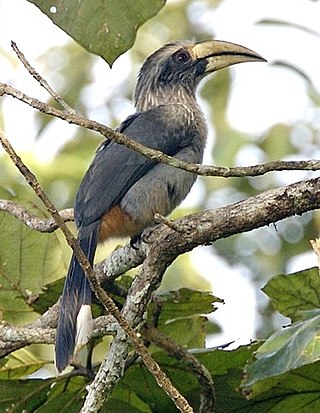
The Malabar gray hornbill is a hornbill endemic to the Western Ghats and associated hills of southern India. They have a large beak but lack the casque that is prominent in some other hornbill species. They are found mainly in dense forest and around rubber, arecanut or coffee plantations. They move around in pairs or small groups, feeding on figs and other forest fruits. Their loud cackling and laughing call makes them familiar to people living in the region.
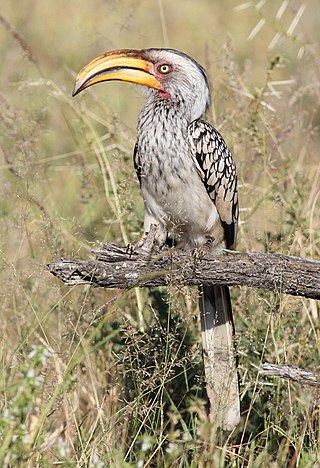
The southern yellow-billed hornbill is a hornbill found in southern Africa. Yellow-billed hornbills feed mainly on the ground, where they forage for seeds, small insects, spiders and scorpions. This hornbill species is a common and widespread resident of dry thornveldt and broad-leafed woodlands. They can often be seen along roads and water courses.
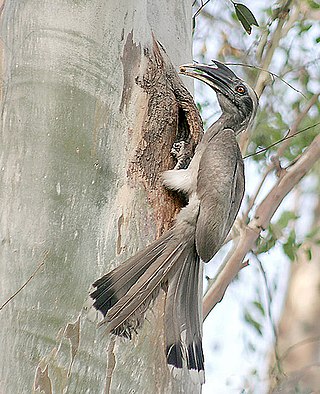
The Indian gray hornbill is a common hornbill found on the Indian subcontinent. It is mostly arboreal and is commonly sighted in pairs. It has grey feathers all over the body with a light grey or dull white belly. The horn is black or dark grey with a casque extending to the point of curvature of the horn. It is one of the few hornbill species found in urban areas in many cities where they are able to make use of large trees in avenues.

The great hornbill, also known as the concave-casqued hornbill, great Indian hornbill or great pied hornbill, is one of the larger members of the hornbill family. It occurs in the Indian subcontinent and Southeast Asia. It is predominantly frugivorous, but also preys on small mammals, reptiles and birds. It has been listed as Vulnerable on the IUCN Red List since 2018. It is known to have lived for nearly 50 years in captivity. Due to its large size and colour, and importance in many tribal cultures and rituals, the Government of Kerala declared it as the official Kerala state bird. It is also the state bird of Arunachal Pradesh.
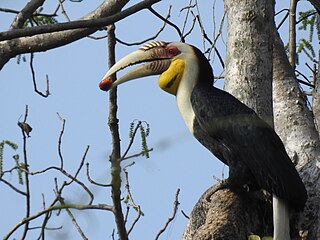
The wreathed hornbill is an Old World tropical bird of the hornbill family Bucerotidae, also called bar-pouched wreathed hornbill due to its distinctive blue-black band on its lower throat sac. It is named after its characteristic long, curved bill that develops ridges, or wreaths, on the casque of the upper mandible in adults. Males are black with a rufous crown, a white upper breast and face, and a yellow featherless throat. Females are uniformly black with a blue throat and are slightly smaller than males.

Bucerotiformes is an order of birds that contains the hornbills, ground hornbills, hoopoes and wood hoopoes. These birds were previously classified as members of Coraciiformes. The clade is distributed in Africa, Asia, Europe and Melanesia.

The black-and-white-casqued hornbill also known as the grey-cheeked hornbill, is a large black and white hornbill. It has an oversized blackish bill with a large casque on top. The female is slightly smaller than the male and has a significantly smaller casque. It is a monogamous species, and pairs nest in suitable tree cavities. The female usually lays up to two eggs. The diet consists mainly of figs, fruits, insects and small animals found in the trees.

The writhed hornbill, also known as the Mindanao wrinkled hornbill, is a species of hornbill in the family Bucerotidae. It is endemic to primarily lowland forests on the Philippine islands of Mindanao, Dinagat and Camiguin Sur. It formerly included the Walden's hornbill as a subspecies, but unlike that species, both sexes of the writhed hornbill have orange-red throat and peri-ocular skin. The writhed hornbill is threatened by habitat loss and hunting.
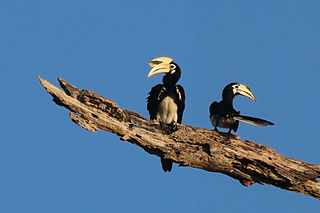
The oriental pied hornbill is an Indo-Malayan pied hornbill, a large canopy-dwelling bird belonging to the family Bucerotidae. Two other common names for this species are Sunda pied hornbill (convexus) and Malaysian pied hornbill.

The Mindoro hornbill is a species of hornbill in the family Bucerotidae. It is endemic to forests on Mindoro in the Philippines found in tropical moist lowland forests. As is the case with all five Philippine tarictic hornbills, formerly considered to be just one species. It is the only tarictic hornbill where both sexes are creamy-white and black. The sexes are very similar, differing primarily in the colour of the ocular ring. It is threatened by habitat loss, and is consequently considered endangered by the IUCN.

The Samar hornbill is a species of hornbill in the family Bucerotidae. It is found in forests on the islands of Samar, Calicoan, Leyte and Bohol in the east-central Philippines. As is the case with all Philippine tarictic hornbills, it has been considered a subspecies of Visayan hornbill Alternatively, it is considered a subspecies of Mindanao hornbill.

The Eastern yellow-billed hornbill, also known as the northern yellow-billed hornbill, is a species of hornbill in the family Bucerotidae. It is found in Djibouti, Eritrea, Ethiopia, Kenya, Somalia, South Sudan, Tanzania, and Uganda. It resembles the southern yellow-billed hornbill, but has blackish skin around the eyes.

The northern red-billed hornbill is a species of hornbill in the family Bucerotidae. It is found from southern Mauritania through Somalia and northeast Tanzania. There are five species of red-billed hornbills recognized, but all five were once considered conspecific and some authorities still classify the others as subspecies of Tockus erythrorhynchus.

The western red-billed hornbill is a species of hornbill in the family Bucerotidae. It is found from Senegal and Gambia to southern Mauritania and western Mali. There are five species of red-billed hornbills generally recognized now, but all five were once considered conspecific. Some authorities still categorize the group as Tockus erythrorhynchus with the remaining four as its subspecies

The southern red-billed hornbill is a species of hornbill in the family Bucerotidae, which is native to the savannas and dryer bushlands of southern Africa. It is replaced by a near-relative, the Damara red-billed hornbill, in the arid woodlands of western Namibia. All five red-billed hornbills were formerly considered conspecific.

The Damara red-billed hornbill is a species of hornbill in the family Bucerotidae. It is found in southwest Angola and northern Namibia. All five red-billed hornbills were formerly considered conspecific.




















